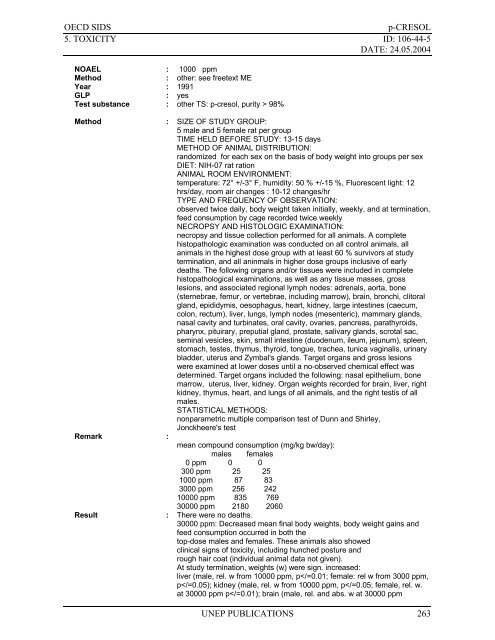m-Cresol - ipcs inchem
m-Cresol - ipcs inchem
m-Cresol - ipcs inchem
You also want an ePaper? Increase the reach of your titles
YUMPU automatically turns print PDFs into web optimized ePapers that Google loves.
OECD SIDS<br />
p-CRESOL<br />
5. TOXICITY ID: 106-44-5<br />
DATE: 24.05.2004<br />
NOAEL : 1000 ppm<br />
Method : other: see freetext ME<br />
Year : 1991<br />
GLP : yes<br />
Test substance : other TS: p-cresol, purity > 98%<br />
Method : SIZE OF STUDY GROUP:<br />
5 male and 5 female rat per group<br />
TIME HELD BEFORE STUDY: 13-15 days<br />
METHOD OF ANIMAL DISTRIBUTION:<br />
randomized for each sex on the basis of body weight into groups per sex<br />
DIET: NIH-07 rat ration<br />
ANIMAL ROOM ENVIRONMENT:<br />
temperature: 72° +/-3° F, humidity: 50 % +/-15 %, Fluorescent light: 12<br />
hrs/day, room air changes : 10-12 changes/hr<br />
TYPE AND FREQUENCY OF OBSERVATION:<br />
observed twice daily, body weight taken initially, weekly, and at termination,<br />
feed consumption by cage recorded twice weekly<br />
NECROPSY AND HISTOLOGIC EXAMINATION:<br />
necropsy and tissue collection performed for all animals. A complete<br />
histopathologic examination was conducted on all control animals, all<br />
animals in the highest dose group with at least 60 % survivors at study<br />
termination, and all aninmals in higher dose groups inclusive of early<br />
deaths. The following organs and/or tissues were included in complete<br />
histopathological examinations, as well as any tissue masses, gross<br />
lesions, and associated regional lymph nodes: adrenals, aorta, bone<br />
(sternebrae, femur, or vertebrae, including marrow), brain, bronchi, clitoral<br />
gland, epididymis, oesophagus, heart, kidney, large intestines (caecum,<br />
colon, rectum), liver, lungs, lymph nodes (mesenteric), mammary glands,<br />
nasal cavity and turbinates, oral cavity, ovaries, pancreas, parathyroids,<br />
pharynx, pituirary, preputial gland, prostate, salivary glands, scrotal sac,<br />
seminal vesicles, skin, small intestine (duodenum, ileum, jejunum), spleen,<br />
stomach, testes, thymus, thyroid, tongue, trachea, tunica vaginalis, urinary<br />
bladder, uterus and Zymbal's glands. Target organs and gross lesions<br />
were examined at lower doses until a no-observed chemical effect was<br />
determined. Target organs included the following: nasal epithelium, bone<br />
marrow, uterus, liver, kidney. Organ weights recorded for brain, liver, right<br />
kidney, thymus, heart, and lungs of all animals, and the right testis of all<br />
males.<br />
STATISTICAL METHODS:<br />
nonparametric multiple comparison test of Dunn and Shirley,<br />
Jonckheere's test<br />
Remark :<br />
mean compound consumption (mg/kg bw/day):<br />
males females<br />
0 ppm 0 0<br />
300 ppm 25 25<br />
1000 ppm 87 83<br />
3000 ppm 256 242<br />
10000 ppm 835 769<br />
30000 ppm 2180 2060<br />
Result : There were no deaths.<br />
30000 ppm: Decreased mean final body weights, body weight gains and<br />
feed consumption occurred in both the<br />
top-dose males and females. These animals also showed<br />
clinical signs of toxicity, including hunched posture and<br />
rough hair coat (individual animal data not given).<br />
At study termination, weights (w) were sign. increased:<br />
liver (male, rel. w from 10000 ppm, p
















